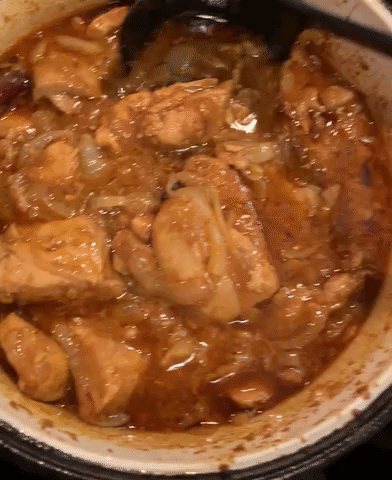'An Invitation to Indian Cooking' by Madhur Jaffrey
'Culinary insularity is really nothing more than a set of stubborn taste habits.'—Review #175

I’m not known to be a good cook. Donna is. My mother is. My uncle is. My cousin is. But not me. My family still teases me about the time, back in college, when I tried to improvise a version of spaghetti and marinara sauce out of instant noodles and leftover salsa. So when the pandemic hit and folks were learning to make bread and such, I thought, well, that’s nice for you all, but not for me. But as months and seasons of The Great British Baking Show passed, I figured OK, fine, I’ll give cooking a try. But whatever I make will probably be poison. I turned to Rad Dishes, my friend and newsletter colleague, and tried her mother’s Channa Chaat recipe. It came out tasting really good, and neither Donna nor I were poisoned. I was impressed with myself, like:

After a year and many bowls of chaat, I wanted to expand my cooking. But how? One morning, Donna heard this Splendid Table interview with actress and cookbook legend Madhur Jaffrey, and Donna suggested I get a copy of her landmark work, ‘An Invitation to Indian Cooking,’ which was originally published in 1973.1
Here’s the cover:

I’ve never reviewed a cookbook before, so I wasn’t sure how to approach this review. To what do I compare these recipes? Do I need to probe and critique the social and political implications of the term ‘American kitchens’? At first I thought I needed a device like ‘Julie & Julia’ and try to make everything from front to back. No, impractical. Then I thought I’d read cover-to-cover through the introduction and lead-ins to chapters about soups, vegetables, meats, fish, breads, dals, chutneys, rice and desserts, and the blurbs that accompany the recipes themselves that are all packed with personal and family anecdotes and Indian history. I did get a lot out of that material, from learning about the origin of the word ‘curry,’ to understanding the prevalence of vegetarianism in India, to the differences between meat in India versus the U.S. (our meat is inflated by water, which Jaffrey makes allowances for), to which fish dish is a specialty of her Bengali sister-in-law, Maya. But it felt more natural to focus on my zigzag and incomplete journey through these recipes and Jaffrey’s background information about them. Here are the highlights:
Mulligatawny Soup
This is the first recipe in the book and the first I attempted. Jaffrey’s paragraph heading this recipe is packed with information about how the dish is an amalgam of British colonial and Indian influences. ‘Judging from the Tamil origin of the name “mulligatawny”…one might deduce that it originated in the Madras region 100 to 300 years ago under the benevolent gaze of British patronage,’ she writes. I’m not sure if ‘benevolent gaze’ is sarcasm, but she goes on to note that the recipe is one she got from family friends who immigrated to Australia. It introduced me to an array of spices I had never used, including turmeric, cumin and coriander, and to one of our neighborhood butchers. The soup tasted great, but I didn’t get enough lamb, and it wasn’t a great cut, either. Also, the portions were small. Donna wants me to make it again, and when I do I will double the recipe so there are leftovers.
Vegetable Pakoris
This recipe for vegetable fritters calls for a deep-fryer, but since I don’t have one, I tried using a skillet with high walls. Probably due to the incorrect equipment, I couldn’t get the the batter of chickpea flower, cayenne pepper and other spices to stick properly to the veggie slices. It kept sliding off! I tried this recipe three times, using potatoes and onion rings, and while the flavor was amazing, it looked a mess. But I had a breakthrough when I made:
Moong Dal
‘This is North India’s most popular dal, and it is eaten with equal relish by toothless toddlers, husky farmers, and effete urban snobs,’ Jaffrey writes. I had to try that. But first I needed a few things. Ghee was pretty easy to find in my neighborhood, where there are many south Asian markets and delis. But my search for a spice called asafetida (or hing) was challenging. I went to every store in a several-block radius of my apartment, from the Green House Deshi Market at the corner of McDonald and Church avenues to our local Food Town, in search of asafetida. No dice. I had to order it online. And the moong dal itself briefly eluded me, too, until I realized it was simply the fairly common mung bean. Jaffrey’s recipe also includes garlic, ginger, Chinese parsley, spices and lemon juice melded with plenty of stirring and stirring. For the final step, I had to heat the ghee on a skillet and, after the clarified butter melted, add a pinch of asafetida. It makes a startling whoosh on the pan. (In other recipes that include this step, Jaffrey advises one to avert their face when adding it.) Despite the excitement, the dal came out absolutely fantastic. I was floored I made such a tasty meal. Donna enjoyed it, too, and so did several friends who came to a small post-Thanksgiving party we threw. They probably didn’t know it was the first time I had ever cooked anything for a friend. It meant a lot to hear they enjoyed it. But my crowning achievement so far has been:
Chicken Moghlai
I can almost smell this delicious-looking GIF. This dish is complicated. I had to use the electric chopper to make a garlic-ginger paste while sautéing onions on the stove. Then I set them aside to sauté cut-up chicken in the same pot before setting it aside, too. I next made a broth with tomato sauce, yogurt, cinnamon and other spices, and the paste, while also soaking saffron in warm milk before bringing everything together to simmer. The result was incredible. It’s a dish I plan to make again, starting with Christmas dinner. Never in my wildest dreams did I think I could advance from instant noodles and salsa to be capable of such a flavorful dish. Achievement unlocked. I felt like Neo in ‘The Matrix’ when he’s like:
Because of email-size constraints, I didn’t include GIFs of all the dishes I made. The cutting-room floor includes a lentil dal, kheema with fried onions, and potatoes with asafetida and cumin. ‘An Invitation to Indian Cooking’ has opened up a culinary world for me. It fills me with joy to make something that tastes great, and to gain insight into a culture, history and family that’s distinct from what I’m familiar with. I am excited to continue my journey through Jaffrey’s recipes—I already plan to make a codfish with yogurt sauce (Maya’s specialty) as well as samosas—and other cookbooks. No matter the complexity of the recipe I tried, Jaffrey’s instructions were clear and relatively easy to follow. I always felt in safe hands, and constantly enriched by her personal and historic anecdotes. I can’t recommend this cookbook enough.
How it begins:
This book has been written as a gradual maneuver in self-defense. Let me explain.
You see, I have lived fairly quietly in New York for more than a decade, but in the last few years I have increasingly found myself approached at parties and P.T.A. meetings by a fresh breed of enthusiastic Americans who note my sari and ask, “You wouldn’t know of a restaurant where we could get some good Indian food, would you?” My answer is always an apologetic, “I am afraid there is no place in New York or anywhere in America where top-quality Indian food can be found—except, of course, in private Indian homes.” At this, their faces fall and I begin to feel a familiar upsurge of guilt and patriotic responsibility. I try to explain about the Indian restaurants. It isn’t as if there aren’t any. But these establishments invariably underestimate both the curiosity and the palate of contemporary Americans. Instead of specializing in food from a particular state or district, they serve a generalized Indian food from no specific area whatsoever; a restaurant may call itself “Kashmir” but will serve no Kashmiri food; at another calling itself “Punjab,” you will be unable to get those delicious Punjabi mainstays, corn bread and mustard greens. There are several reasons for this. One is timidity—the fear that diners’ unfamiliarity with regional specialties will make certain dishes unpopular. Another is the caliber of the cooks: most are former seamen who left their ships with the hope of making a living, somehow or other, in America, and as cooking seemed to require no unusual skills, a great many have become restaurateurs, copying the standardized menus of other Indian restaurants and refusing to experiment with dishes from their own villages which they perhaps knew much better. The result of all this is that the sauces in such eating places inevitably have the same color, taste, and consistency; the dishes generally come “mild, medium, or hot",” which is an indication that the food is not being cooked with the spices, as it should be, but that something is being ladled on; appetizers are suggested not because Indians eat them, but because it is felt that Americans cannot do without them.
My rating:
‘An Invitation to Indian Cooking’ by Madhur Jaffrey was published by Alfred A. Knopf in 1973 and by Vintage Books in 1975. 300 pages, including glossary, sources list and index. $20.24 on Bookshop.org.
Let’s discuss:
What’s your favorite cookbook?
What’s next:
Before you go:
ICYMI: Review #174
Read this: Taco Bell Quarterly has published the most beautiful and heartbreaking cat poem I have ever read.
Do this: BoG friend Jennifer from KitchenWitch is hosting a virtual workshop on tyromancy, which is fortune telling with cheese. This is so fascinating that I am thinking of attending. The event is on Sat., Jan. 8, at 2 p.m., Central time. $20. Click here for additional info.
Click these: RIP, Eve Babitz.2 Thanks for the shoutout, SoNovelicious! And this whole thread is amazing:
Thanks to Donna for editing this newsletter, and thanks to all of you for supporting Books on GIF in 2021. It was a tremendous year, and we’re excited for what’s to come:

MPV
Newsletters you ♥️ the most
It was inducted into the James Beard Cookbook Hall of Fame in 2006.
I reviewed ‘Eve’s Hollywood’ back in 2017.

















This review is actually an inspiring tale of personal re-invention. I’ve been gradually reading Samin Nosrat’s “Salt Fat Acid Heat” cookbook like a novel I dip in and out of. It’s well written and educational and I recommend it.
What a fun newsletter! I’m so glad you got to try making new things and had some success at that :)